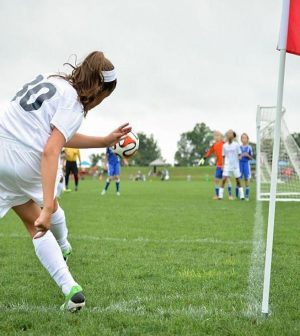- Navigating Your Midlife Crisis: Embracing New Possibilities
- City Raccoons Showing Signs of Domestication
- Mapping the Exposome: Science Broadens Focus to Environmental Disease Triggers
- One Week Less on Social Media Linked to Better Mental Health
- Your Brain Changes in Stages as You Age, Study Finds
- Some Suicide Victims Show No Typical Warning Signs, Study Finds
- ByHeart Formula Faces Lawsuits After Babies Sickened With Botulism
- Switch to Vegan Diet Could Cut Your Greenhouse Gas Emissions in Half
- Regular Bedtime Does Wonders for Blood Pressure
- Dining Alone Could Mean Worse Nutrition for Seniors
Getting Young Athletes Ready for a New School Year

As a new school year begins, many students return to their favorite sports or try something new.
Encouraging kids to make physical activity part of their lives has lifelong benefits, said Dr. Theodore Shybut, assistant professor of orthopedic surgery and sports medicine at Baylor College of Medicine in Houston.
Shybut offered some tips for getting children ready to start fall sports or any physical activities at any age. His advice comes at a time when many youngsters may be losing interest in organized sports.
Shybut recommends giving the youngest kids opportunities to explore many activities to see what they like best. Create an environment in which a child feels encouraged to be active with routine free play at home, family walks or trying out the latest exercise trend.
“Keep it fun and interesting. The goal is to cement the idea of exercise as an enjoyable and healthy habit,” Shybut said in a college news release. “Once your child latches onto something they like, then you can then work together to begin mastering the fundamentals of the activity they choose to pursue in the long term.”
Kids and teens who have already participated in organized sports at school or in community leagues should be given opportunities to stay active during their off-seasons. Appropriate drills or training camps can get them ready for a new season and help prevent injury.
In hot regions, the need to beat the heat is key.
“It’s important for athletes to adjust to heat and sun exposure,” Shybut said. “Even a week of regular exercise before group training sessions begin can be beneficial. Additionally, ensuring young athletes are properly hydrated is vital to preventing serious heat-related illnesses.”
Make sure kids get the chance to recover from workouts with proper diet and sleep. Keys are a healthy sleep schedule and diet rich in unprocessed foods, such as fruits, whole grains, beans, nuts and vegetables, plus complex carbohydrates and proteins.
Young athletes’ diets should be tailored to the sport they do. Those who have heavy training loads, such as competitive swimmers, for instance, may need to eat throughout the day to get all the calories they need.
“Above all, their activity should be healthy and enjoyable,” Shybut said.
Always take a child’s complaint of pain seriously, he stressed. Children do not tend to exaggerate symptoms of injury, Shybut said. A young athlete having trouble running, throwing or performing in the way that’s normal for the child should see a sports medicine professional.
“Some of the most common injuries young athletes experience are a result of pushing too much too fast too quickly,” Shybut noted.
“Junior high and high school athletes may have access to their team’s athletic trainers [ATs], who can often identify the problem and the correct course to address the problem,” he said. “ATs are also knowledgeable about preventing injury. If there is not a training staff available, many resources developed by reputable athletic organizations, like STOP Sports Injuries, can be used to help ensure young athletes stay safe.”
More information
The American Academy of Child and Adolescent Psychology has more on sports and children.
SOURCE: Baylor College of Medicine, news release, Aug. 3, 2022
Source: HealthDay
Copyright © 2025 HealthDay. All rights reserved.










